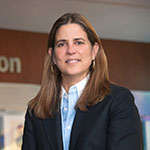UM’s Sergio Gonzalez played a lead role in the $1.4-billion fundraising campaign Momentum, which ended in 2007. Gonzalez is now nearing the end of a second campaign, Momentum2, with a target of raising $1.6 billion by 2016 for medical research and to increase financial aid. Hispanic Executive sits down with Gonzalez to catch up on how Momentum2 is going and talk about the impact it will have on the Florida’s top college.
Hispanic Executive: How is the Momentum2 campaign going?
Thanks to the dedication of our fundraising team and remarkable generosity of our donors, we actually already surpassed our $1.6-billion campaign goal one year ahead of schedule. Even more significant, this achievement occurs on the heels of our Momentum fundraising campaign, which exceeded our target amount and raised $1.4 billion by its 2007 completion. Together, Momentum and Momentum2 raised more than $3 billion so far. Campaign success is a testament to the confidence people have in our mission and ability to transform lives through teaching, research, and service. We are the first private university established in the 20th century to raise more than $1 billion in a fundraising campaign.
How are the funds raised in both Momentum and Momentum2 being implemented?
For every campaign, you do a lot of planning and develop a list of priorities that you hope your donors invest in—but in the middle, you’re going to have to change priorities for a number of reasons. Both campaigns have changed the face of the University of Miami. When I say the face, I’m talking about the buildings. We’ve renovated or built 55 new buildings on campus. We’ve improved not only the aesthetics of buildings and look of the campus, but most importantly, what happens inside those buildings for our students, clinicians, and faculty.
The second implementation has been in our ability to recruit world-class faculty and researchers. And the third, which is critical, is our ability to provide funds for scholarships. We’ve raised $300 million in these two campaigns so far for both financial aid and merit-based scholarships.
What are the responsibilities involved in managing fundraising campaigns of this size?
As the senior vice president for advancement and external affairs, my role is to oversee development, communications, alumni relations, and government and community relations. I supervise all of the aspects of the university’s external relations with various stakeholders. I maintain a comprehensive view of how our fundraising efforts impact the university as a whole. I’m proud to have worked very closely with President Donna Shalala to build and maintain many solid relationships with donors that have led to many transformative gifts.
The other responsibilities I have that are critical to our success are recruiting, hiring, and retaining a quality team to work with us on all of these functions. One of the things I’m proudest of is the great team that we recruited as part of our staff at the university. My team is really talented. They’re at the top of their field—not only locally and regionally, but nationally.
What have been some of your fundraising strategies?
First, we wanted to form a team of relationship builders. Second, we recognized early on that our donors are not only our alumni but also a broader group of philanthropic citizens interested in the outcomes resulting from the research conducted at UM. Third, we identified a list of key priorities that projected a vision of where UM wanted to go as an institution and to which our prospects would have some affinity.
The other component of the strategy was to prioritize fundraising at all levels of the university. Beyond external fundraising, we created an internal culture of philanthropy that included leaders at every level—from academic deans to administrative leaders—who also participated in our fundraising success. Our culture of philanthropy has made a tremendous difference at our institution. UM fundraising ranks 37th in total private support among 851 private and public universities reporting to the Council for Advancement and Support of Education (CASE), and we were recently recognized with CASE’s Overall Performance Award for a Superior Fundraising Program.
What lessons did you take from Momentum that you wanted to be sure to implement in the Momentum2 campaign?
We wanted to maintain our focus on excellence while communicating to donors that we understood how they wanted us to invest their donations. We were able to build on the success of our first Momentum campaign by demonstrating accountability, and that led to an opportunity for reinvestment.
My philosophy is that our best prospects are our existing donors. I say that because these are folks who already demonstrated an affinity for, and interest in, our institution and what we do. If we meet their expectations, they will reinvest in us.
Overall, what does it mean to the school to see these campaigns have so much success?
Without the generosity of our donors and the money we’ve been able to raise, it would not have been possible to bring the University of Miami to the level where it is today. Through our campaigns, we have been able to fund numerous endowed chairs for faculty, add dozens of new scholarships to attract and retain talented students, and support the breadth of interdisciplinary research that has made us one of the top research universities in the country.
What makes you so passionate, personally, about the university?
Almost fourteen years ago, I came here to work with President Shalala. I had never raised money before nor worked in academia, but she gave me the opportunity to take on this role. I didn’t attend the University of Miami, but I did grow up in South Florida and love this institution. In my heart, I’ve been a ’Cane all of my life. To join forces with President Shalala, our trustees, and our donors to promote excellence at a record pace and touch lives like we do is incredibly gratifying and a privilege.

